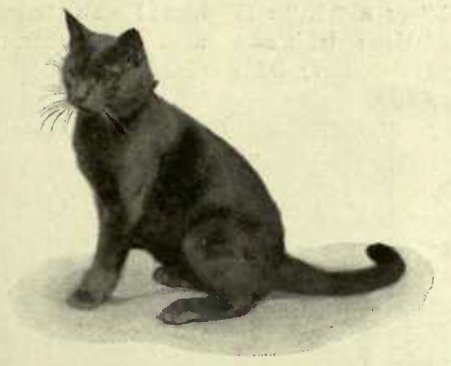I. CATS OF THE PAST
Texte und Bilder aus „THE BOOK OF THE CAT“ von Frances Simpson aus dem Jahre 1903
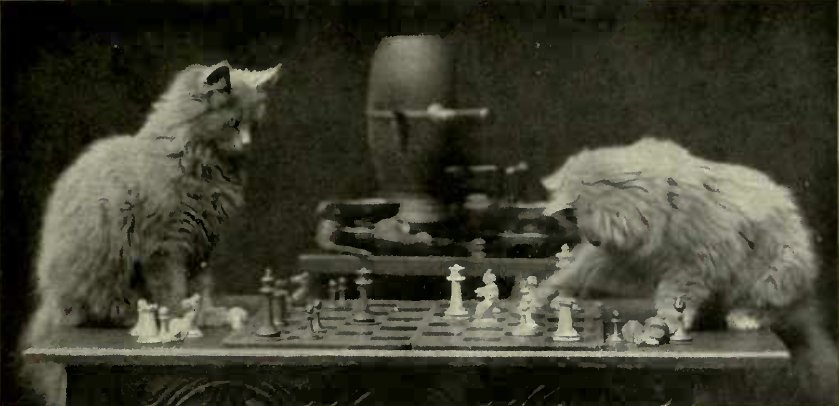
THE BOOK OF THE CAT
CHAPTER I
CATS OF THE PAST

The origin of the cat has puzzled the learned, and the stock from whence it sprang is still, in the opinion of some, a mystery for the zoologist to solve.
Historians tell us that the feline race came into existence about the same time as the horse. Reference is made to the cat in Sanskrit writings over 2,000 years old, and still earlier records are found in the monumental figures, inscriptions, and cat mummies of ancient Egypt. These carefully-preserved relics of the past mummy of a assist us in answering the question as to how this least tameable of animals became domesticated. There are many legends concerning Puss and the manner in which she first sprang into existence. A surprising account of the cat’s creation is found in the works of an Arabian naturalist. It is as follows : „When Noah made a couple of each kind of animal enter the Ark, his companions, as well as the members of his family, said to him, ‚ What security can there be for us and for the animals so long as the lion shall dwell with us in the same vessel ? ‚ The patriarch betook himself to prayer and entreated the Lord God. Immediately fever came down from Heaven and seized upon the king of beasts, so that tranquility of mind was restored to the inhabitants of the Ark. But there was in the vessel an enemy no less harmful this was the mouse. The companions of Noah called his attention to the fact that it would be impossible for them to preserve their provisions and their clothes intact. After the patriarch had addressed renewed supplications to the Most High, the lion sneezed, and a cat ran out of his nostrils. From that time forth the mouse became so timid that it contracted the habit of hiding itself in holes.“
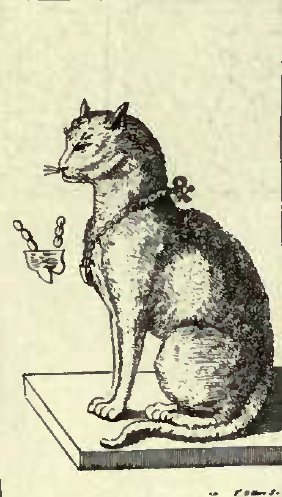
So runs the legend, and in an old Italian picture representing the departure from the Ark we may observe a big brindled cat leading the procession of animals with an air of dignity and self-satisfaction. According to the Arabic scholar Damirei, there was no cat in the Garden of Eden. It is a singular fact that nowhere in the canonical books of the Old Testament or in the New Testament is the cat mentioned, and if we take into consideration the number of books connected with the life, manners, customs, and religions of the Egyptians, this omission is the more striking. The only Biblical reference to cats occurs in the Book of Baruch, chap, vi., v. 22. This is a letter by Jeremy to the Children of Israel, who were taken captive by Nebuchadnezzar to Babylon. Some Hebrew scholars have asserted that the animals that prowled and cried among the ruins of Babylon were jackals, and not cats.
But however much the origin of the feline tribe is wrapped in mystery, we are certain that more than 3,000 years ago the cat lived and was loved along the banks of the Nile. The ancient city of the Pharaohs paid her homage ; she was admitted into the ranks of sacred animals, she was worshipped in the temples. Jewels were placed in her ears and necklaces about her neck. Figures of cats were kept in the home and buried in the tomb. Trinkets representing both the goddess and the cat were worn upon the person, to indicate special devotion on the part of the wearer. There seems but little doubt that the ancient and well-beloved cat of the Egyptians was a barred or marked animal, answering to some extent to our homely tabby. Paintings and statuettes of this type frequently occur, and therefore we may it take for granted that the Egyptians, who were so realistic and true to Nature when dealing with the animal world, would have presented cats of other species had they existed. According to the historian, animal worship was first introduced into Egypt by Chores, the second king of the Second Dynasty.
The Egyptians made gods of many living creatures of all kinds, amongst others the bull, the crocodile, the ibis, the hawk, the beetle, and the asp ; but the cat appears to have held the highest place in their hearts. Not only was it preserved from injury, beloved and venerated during life, but at its death it was buried with all respect, and everyone mourned for it with outward and visible signs of grief, even to the extent of shaving off their eyebrows.
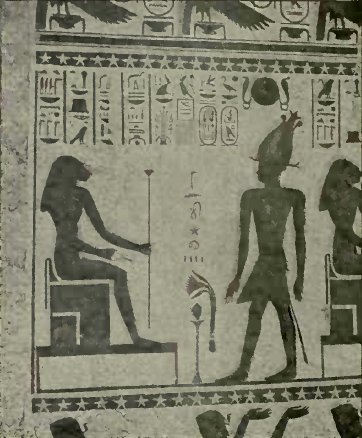
The Egyptian’s idea of a correct burial involved mummification, so that all the parts might be preserved and thus kept from annihilation against the day of resurrection. A rich man’s cat was very elaborately mummified. Different coloured stuffs were twisted round and round the body, forming curious patterns in two colours. The head would be carefully encased and sometimes gilded ; the ears were always standing upright. These curious mummies look something like bottles of rare wine done up in plaited straw. Sometimes the mummy would be enclosed in a bronze box with a statue of a cat seated on the top. Mummies of cats with painted faces have been found in wooden coffins at Bubastes, Specs, Artemidos, Thebes, and elsewhere. Here is an illustration of a kitten brought to me from the Boulak Museum. The picture gives but little idea of the care and neatness which must have been employed in wrapping up the dear little dead bodies. The linen used is of the finest. The ears of the tiny kitten are each separate and distinct, and the muzzle of the creature shows distinctly through the delicate wrappings. Scarcely a good museum in the country now that has not some specimens of cat mummies.
In some of these we notice that eyes have been added after the mummy has been encased and the embalmment completed. Most of the cats that died in the far-away time were thus embalmed and sent for burial to the holy city of Bubastes, near Thebes, on the banks of the Nile.
The Temple of Bubastes, according to Herodotus, was the fairest in all Egypt, and here special reverence was paid the cat. The local goddess of this city was Pasht, who was represented as a woman with a cat’s head. Cats were kept in the temples sacred to them, and doubtless the head cat of the Pasht’s temple was a very splendid specimen, who, living the life of great luxury, would be buried with the pomp and magnificence of a royal personage.
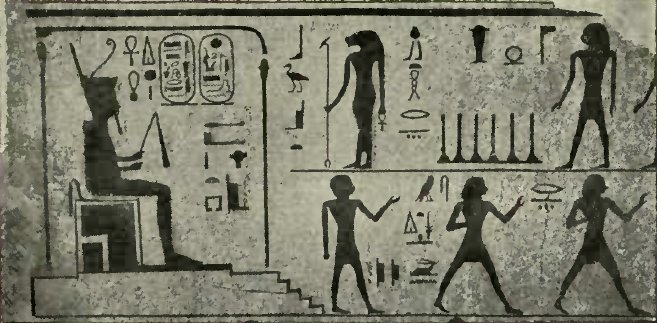
It was at Bubastes, on the banks of the Nile, that an annual festival in honour of the goddess Pasht was held. We are not told whether the cats took any part in the proceedings. From the towns and villages within hail, pleasure parties were sent in boats up and down the river to thecity, and on their passage the men and women who crowded these boats made merry all the long summer day.
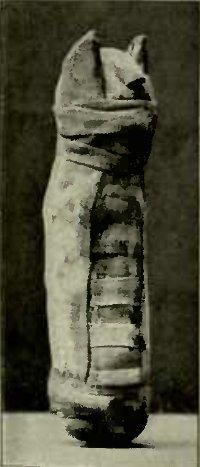
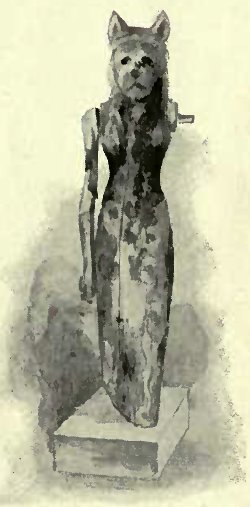
The women clashed (From Hit British Museum.) their cymbals and danced, and the men played on their flutes. Seventy thousand people, it is said, assembled at this feast, and they sacrificed victims and drank a good deal of wine. Perhaps the cats were treated to an extra dish of some dainty to mark this red-letter day in the annals of their patroness and goddess.
A curious custom, which probably had its origin in these pilgrimages to the sacred shrine. had until recent years survived amongst the Egyptian Moslems, who when they were starting on their way to Mecca always set apart one camel for the conveyance of several cats, and some ancient dame was told off to take Beni Hasan, one hundred miles from Cairo.
A few years ago some excavations were made near this town, and thousands of little mummied bodies were found that had rested peacefully for centuries. Their graves were desecrated, their burying-ground plundered, and tons and tons of mummied forms were carted ‚away to charge of the precious animals. She was honoured with the title of “ Mother of Cats.“ Her office was not an enviable one, and probably it was found that a woman was unable to wrestle satisfactorily with the refractory travellers, for at a later date a man was substituted to carry the pussies to the Holy City.
Thebes appears to have been a favourite burying-place for cats, and also a place called the neighbouring fields to serve the useful, if not romantic, purpose of manure ! According to Horopollo, the cat was worshipped in the temple of Heliopolis, because the size of the pupil of the animal’s eye is regulated by the rising and waning of the sun. Plutarch, however, states in his treatise on “ Isis and Osiris “ that the image of a female cat was placed at the top of the sistrum as an emblem of the moon. “ This,“ says the historian, “ was on account of the variety of her fur, and because she is astir at night ; and furthermore, because she bears firstly one kitten at a birth, and at the second two, at the third three, and then four, and then five, until the seventh time, so that she bears in all twenty-eight, as many as the moon has days. Now this, perchance, is fabulous, but ‚tis most true that her eyes do enlarge and grow full at the full moon, and that on the contrary they contract and diminish at the decline of the same.“
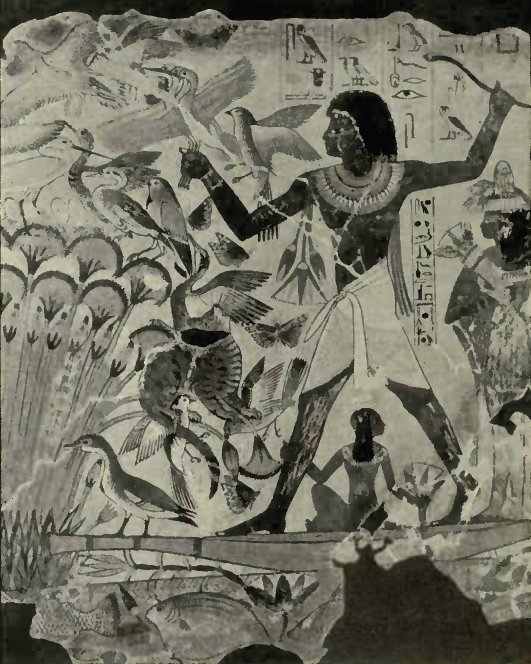
Among other fables of classic naturalists and historians may be mentioned the following by Herodotus : “ If a fire occurs, cats are subject to supernatural impulses ; and while the Egyptians ranged in lines with gaps between them, are much more solicitous to save their cats than to extinguish the fire, these animals slip through the empty spaces, spring over the men’s shoulders, and fling themselves into the flames. When such accidents happen, profound ,grief falls upon the Egyptians.“
Whether these frenzied cats did or did not commit suicide is open to doubt, but that they would plunge fearlessly into water is an acknowledged fact. This is attested by paintings representing sporting scenes in the valley of the Nile. Men and women used to go out on fowling excursions in a boat to the jungles and thickets of the marsh land, or to lakes in their own grounds, which abounded with wild fowl, and there among the tall reeds knock down the bird with a stick. Into these happy hunting grounds they took a cat who would jump into the water and retrieve the game as it fell. There is a painting taken and brought from a tomb in Thebes, which is now in the British Museum, and Wilkinson, in his “ Manners and Customs of Ancient Egyptians,“ writes as follows : „A favourite cat sometimes accompanied the Egyptian sportsmen on these occasions, and the artist intends to show us, by the exactness with which he represents the animal seizing the game, that cats were trained to hunt and carry the water-fowl.“
One of the earliest representations of the cat is „to-be-found in the Necropolis of Thebes, which contains the tomb of Hana, who probably belonged to the Eleventh Dynasty. There is a statue of the king standing erect, with his cat Bouhaki between his feet. The large basalt statues, of which there are so many in the British Museum, both seated and standing, are examples of great interest. They have mostly the disc of lunar divinity above their heads and the royal asp above the forehead.
M. Champfleury, in his delightful book, “ Les Chats,“ gives a good deal of information regarding the cats of ancient Egypt, and mentions the existence of funerary statues of women which bear the inscription Techau, the cat, in token of the patronage of the goddess Bast. Frenchmen occasionally call their wives ma chattc without attaching any hieratic association to that term of endearment.
According to ancient documents in the Louvre, we are enabled to surmise the name by which the cat was known in Egypt. It was Mau-Mai‘, Maau, or Maon. A tablet in the Berlin Museum, bearing the representation of a cat, dates from 1600 B.C., and another, two hundred years older, has an inscription in which the word “ Mau “ appears. Amongst old Egyptian images in bronze and earthenware, we may often find the cat crouching with the symbolic eye, emblem of the sun, engraved upon its collar. In the British Museum there is a curious example of a toy in the shape of a wooden cat with inlaid glass eyes and a movable lower jaw well lined with teeth.
There is a tradition that Cambyses devised a scheme for the capture of the town of Peluse, which, if true, is one example among many of the devotion of the Egyptians to cats. It was in the fourtmont year of his reign that this King of Persia tried to effect an entry into Egypt and he is said to have bit upon a clever strategy. Knowing that the garnison of the town was entirely composied of Egyptians, be put at the head of his army soldiers each carring in their arms a Cat. The Egyptians, alarmed lest they might injure the sacred animals when destroying their enemies, conseuted rather to be vanquished. But for their scruples they might pethaps have repulsed the invaders, for the Persian soldiers
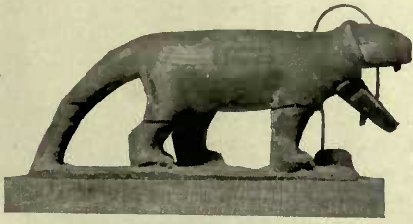
could not well have done their share of tge fighting while chlasping in their arms restless and terrified cats!
It is strange that the cat was almost neglected by the Greeks and Romans. It is true that Grecian art working on such grand sweeping lines might fail to follow the insignificant yet graceful curces of the cat. Therefor no Greek monument is adorned with a figure of the idol of Egypt and Homer never gives a passing mention of the cat. Among the Greeks the cat was sacred to the goddess Diana. Mythologists pretend that Diana created the cat in order to throw rdieule upon the lion, an animal supposed to have been called into existence by Apollo with the intention of frightening his sister. This befollowed up py producing a mouse. Which Hecate’s cat immediately ate up.
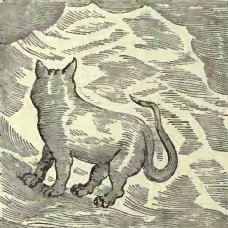
A cat was often emblazoned on the shields and flags of Roman soldiers. That the cat was known at an early period in Italy we have proof in the curios mosaic in the Museum at Naples, which depicts one pouncing upon a bird.
The date of this has been fidex at about one hundred years prior to the Christian era. In the Bordeaux Musuem there is a tob of the Gello-Roman Period with a representation of a girl holding a cat in her arms and with at cook at her feet. In those days the playthings and domestic animals belonging to children were buried with them.
From some of the oldest Indian fables we learn that the cat was domesticate in that country at a very early period. Her first appearance into China would seem to have been about 400. A.D.
There is a curious ancient Chinese saying that
“ A lame cat is better than a swift horse when rats infest a palace.”
Amongst the curious freaks in the natural world are mineral lusus. These are stones agates, or marbles, which, by the action of soil, air, or water during thousands of years, have assumed various Forms, which we may interpret to represent human heads, trees, animals and so forth. This illustration of a mineral lusus is taken on a reduced scale from a book by Aldrovandus, an Italian naturalist of the seventeenth century. The figure of the cat occurs, he says, in a slab of marble. It was also reproduced by Athanasius Kircher, the Jesuit, who copied many of Aldrovandus’s engravings.
I think the most casual observer would pronounce this illustration to be the representation of a cat; and if, as we are led to believe, this and other figures are really the result of natural causes, we can only marvel at the wonderful correctness of outline and form in which through countless ages the substances comprising the specimen have arranged themselves.
We have no record that the cat became domesticated in Great Britain and France before the ninth century, when it would seem that she was by no means common, and considered of great value; for in the time of one of the old Princes of Wales, who died in 948, the price of a kitten before it could see was fixed at a penny, after it had captured a mouse, twopence; and if it gave further proofs of its usefulness it was rated at fourpence.
This same price, Howel the Good, ssued an order that anyone who stole or killed a cat that guarded the prince’s granary was to forfeit a milch ewe, its fleece, and lamb, or as much wheat as when poured on the cat suspended by its tail (the head touching the floor) would form a heap high enough to cover the top of the tail.
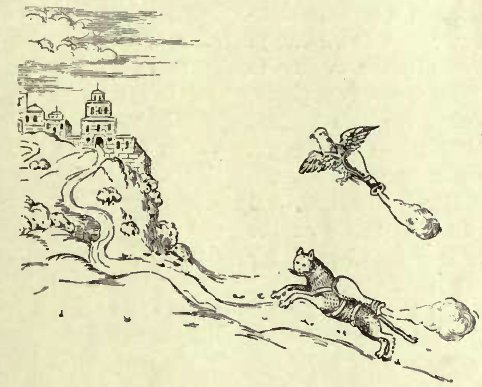
This is not only curious, as being an evidence of the simplicity of ancient customs, but it goes far to prove that cats were not aborigines of these islands. The large price set on them if we consider the high value of specie at that time – and the great care taken of the improvement and breed of an animal that multiplies so quickly, are almost certain proofs of their being little known at that period. No doubt wild cats abounded in our islands, and this creature is described by Pennant as being three or four times as large as the house cat. The teeth and claws are, to use his expression, “ tremendous,“ and the animal is altgether more robust.
The tail of the wild cat is thick and as large at the extremity as it is in the centre and at the base ; that of the house cat tapers to the tip. This ferocious creature, well named the British tiger, was formerly common enough in the wooded and mountainous districts of England, Scotland, and Wales, but owing to the attention paid to the preservation of game it has gradually become almost if not entirely exterminated. In olden times, when wild cats were hunted and captured, the principal use they were put to was to trim with their fur the garments of the ladies in the various nunneries scattered over the land. A writer of the Middle Ages says : “ The peasants wore cat skins, badger skins, &c.“ It would appear that lambs‘ ana cats‘ skins were of equal value at that period.
Harrison Weir, in his work on cats, tells us that in 1871 and 1872 a wild cat was exhibited at the Crystal Palace by the Earl of Hopetoun ; he also mentions that as late as 1889 Mr. Edward Hamilton, M.D., writing to the Field, gives information of a wild cat being shot at Inverness-shire.
He states : “ A fine specimen- of a wild cat was sent to me on May 3rd, trapped on the Ben Nevis range. Its dimensions were : „from nose to base of tail, i foot; height at shoulders, i foot 2 inches.“ In July, 1900, a paragraph to the following effect appeared in the Stock- Keeper :
“ The Zoological Society have just acquired a litter of wild cats. This is the only instance where a whole litter has been sent to the Gardens. It was taken not frar from Spean-Bridge, Inverness-Shire.”
The late Professor Rolleston, in an article on the “ Domestic Cats of Ancient and Modern Times “ (Journal of Anatomy and Physiology), has well explained much of the confusion about cats in former writers and their so-called interpreters. He shows how loosely now, as long ago, the word “ cat “ and its classic equivalents may be employed. Just as we still speak of civet cats and martens. Up to the beginning of this century the wild cat was wrongly thought to be the original of the tame species. Yet apart from more exact evidence this is shown to be an error if we note the value set upon domestic cats in former centuries. The Rev. Dr. Fleming, in his “ History of British Animals“ (1828), points out some of the distinctions between the two species. He also alludes to the spotted variety, termed the Cypress Cat, as noticed by Menet, who wrote the earliest book on British Natural History in 1667.
“ It is a curious fact,“ says Mr. J. E. Herting, an eminent naturalist, “ that in Ireland, notwithstanding reports to the contrary, all endeavours to find a genuine wild cat have failed, the so-called ‚ wild cat ‚ of the natives proving to be the ‚ marten cat,‘ a very different animal.“
In the early Middle Ages, according to tradition, cats were utilised in a strange manner. The illustration on p. 7 depicts a German fortress which it was desired by the enemy to set on fire. Not being able, one may suppose, to effect this by treachery, the foes pressed into their service both biped and quadruped. On the back of the pigeon and cat alike, a flask of inflammable matter is attached, and furnished with a time fuse to ignite at the proper moment. There is a broad road for the cat to travel, and we must presume that the gate of the fortress was left open for her entrance. The pigeon would be supposed to cut the cord of the flask with her beak when just over the magazine and let it drop at an auspicious moment. This cut is reduced from a coloured drawing in an unpublished manuscript volume dated 1575, in which is a great variety of illustrations of fireworks for war and recreation.
It is strange that the cat, which was an object of worship and adoration to the Egyptians, should, during the long, dark years of mediaeval history, be looked upon as a diabolical creature. The only pleasant legend handed down to us from the r „Middle Ages is that of “ Dick Whittington and his Cat.“ There are records to show that this worthy citizen was thrice Lord Mayor of London, and we have always been led to believe that it was to his cat he owed his wealth and prosperity. At all events, so long as London is London, Whittington will ever be associated with his cat.
Innumerable are the legends that gather round the cat during the Middle Ages. It was believed that the devil borrowed the coat of a black cat when he wished to torment his victims. Sorcerers pretended to cure epilepsy by the help of three drops of blood taken from the vein under a cat’s tail. At numerous trials for witchcraft, puss figured as the wicked associate of the accused. Cats were offered by sorcerers as oblations to Satan, and they were flung into the fire at the Festival of St. John.
All praise to Louis XIII., who as the Dauphin interceded for the lives, of these poor pussies thus annually sacrificed. It was thought to bring good luck to a house if a cat were cooked alive in a brick oven, and in Scotland she was roasted before a slow fire as a means of divining the future.
The mania of witchcraft had pervaded all ranks, even the holy profession, whose duty it should be to preach peace and goodwill. Hundreds of wretched old women were sent out of life “ in a red gown “ (the slang of that day for being burnt “ quick “ or alive), after undergoing the most excruciating tortures to make them confess the impossibilities for which they suffered.
In 1591, when King James of Scotland was crossing from Denmark, a great tempest arose at sea. This was supposed to have been caused by a “ christened cat “ being placed in the vessel by witches. The following is an extract from an old pamphlet : “ Againe it is confessed that the said christened cat was the cause that the Kings Majestie’s shippe had a contrarie wind to the rest of the shippes in his companie, for when the rest of the shippes had a fair and good winde, then was the winde contrarie and altogether against his Majestie.“ Thus, in the past as in the present day, blame was laid upon the poor harmless puss, where no blame was due.
In an old book called “ Twenty Lookes over all the Roundheads of the World,“ published in 1643, we read : “ In the Reigne of Oueene Mary (at which time Popery was much exalted) then were the Roundheads (namely, the monks and friars) so odious to the people, that in derision of them a cat was taken on a Sabbath day, with her head shorne as a Fryer’s and the likenesse of a vestment cast over her, with her feet tied together, and a round piece of paper like a singing Celse between them ; and thus was she hanged in a gallows in Cheapside, neere to the Crosse, in the Parish of St. Matthew. Which cat, being taken down, was sent to Doctor Pendleton (who was then preaching at St. Paul’s Cross), commanding it to be shown to the congregation. The Round-head Fryers cannot abide to heare of this cat.“
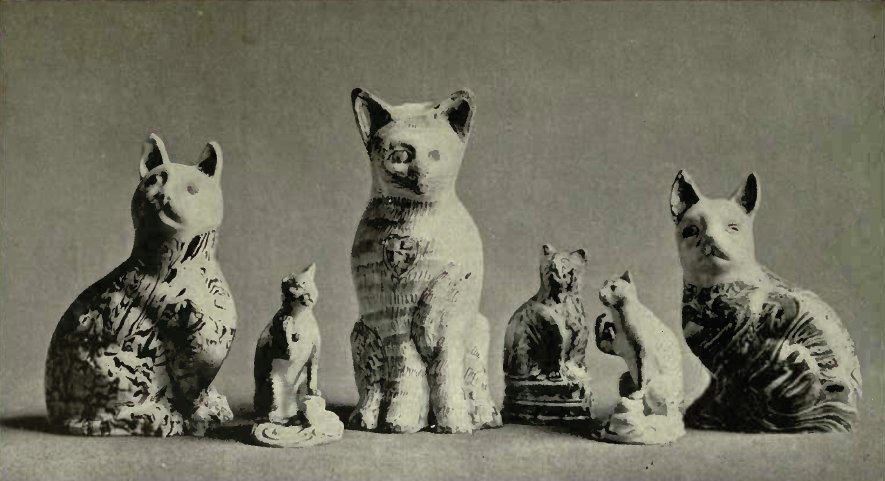
At the coronation of Elizabeth there is an account given, in the Hatton correspondence, of an effigy of the Pope being carried through the streets and afterwards burnt with several live cats, which, we are told, “ squalled in a most hideous manner “ as soon as they felt the fire.
After a famous French trial in the seventeenth century, a woman condemned as a murderess was hung in an iron cage over a slow fire, and fourteen poor unoffending cats were made to share the same fate. It is difficult to conceive by what train of thought civilised beings could arrive at such a pitch of wicked and horrible cruelty. Why should a gentle, shrinking, graceful little creature be thus made the savage sport of devils in human form ?
There seems, however, to have been one haven of rest for poor persecuted pussy during the Middle Ages, and that was in the nunneries. Here, at least, she would be kindly treated, let us hope. It is said that this fact has something to do with the cat’s traditional association with old maids.

And now let us quit this dark page of history, where the shameful treatment of an innocent race makes the lover of the poor pussies sorrowful and indignant. It was in France that, after the period when the cat was given over to the ways of the witch and the sorcerer, we find her yet again taking her proper place in the home and the heart of the highest in the land. Writers of natural history and others frequently denounce the cat as an animal incapable of personal attachment, yet puss has wooed and won the friendship and affection of many notable men.
Cats, the most politic, the most polite, and in proportion to their size the most powerful of beasts realising almost literally Napoleon’s favourite maxim, “ Iron hand in velvet glove “ have the permanent fame of being loved by that most eminent of Frenchmen, Cardinal Richelieu, who delighted to watch the frolics of a number of kittens by which he was gener- ally surrounded in his leisure hours. In this tendresse he resembled a still more famous Churchman ! A cat went to sleep once, we are told, on the sleeve of Mahomet’s robe. The hour of prayer arrived, and he chose rather to cut away his sleeve than to disturb the slumbers of his beloved Muezza.
Chateaubriand makes frequent mention of the cat in his “ Memoires.“ He received a present of a cat from the Pope. Moncrieff wrote a series of quaintly worded letters on cats, and the book has some curious illustrations. In this we read of the pussies of many grand dames of the French Court of that day.
We give an illustration taken from this book, which represents the tomb of a cat which belonged to Madame Lesdiguieres, and bears this inscription :
UNE CHATTE JOLIE.
Sa maitresse qui n’aima rien
, L’aima jusques a la folie.
Pourquoi le dire ? On le voit bien.
Moncrieff had to suffer an immense amount of ridicule on account of his charming “ Lettres sur les Chats,“ which the author himself calls „a gravely frivolous book.“ Victor Hugo had a favourite cat ho called “ Chanome,“ and Gautier’s cat slept in his bed, and always kept him company at meals. Petrarch loved his cat as he loved his Laura. Dr. Johnson used to indulge his cat Hodge with oyster^ which he would go out himself to purchase. Chesteifield provided for his cat in his will. Sir Walter Scott’s love of dogs did not prevent him delighting in the company of a “ conversable cat,“ and Hunse, of Hunsefield, seems to have possessed a large share of the great man’s affection, and when he died his master wrote thus to Richardson : “ Alack-a-day ! my poor cat, Hime, my acquaintance, and in some sort my friend of fifteen years, was snapped at even by that paynim, Nimrod. What could I say to him, but what Brantome said to some ferraillcur who had been too successful in a duel : ‚Ah, mon grand ami, vous avez tue mon autre grand ami.‘ “
Amongst famous French novelists several have been cat lovers, especially Dumas, who in his “ Memoires“ makes notable mention of “ Le Docteur.“ Cowper, Shelley, Wordsworth, Swinburne, and Matthew Arnold all wrote lovingly of cats. But Shakespeare, although he makes forty-four distinct mentions of cats, never has a good word for poor pussy. In “ All’s Well that Ends Well “ he gives vent to his dislike.
Bertram rages forth : “ I could endure anything before me but a cat, and now he’s cat to me.“
In “ Cymbeline “ occurs this passage : “ In killing creatures vile as cats and dogs “ ; and in “ Midsummer Night’s Dream “ Lysander is made to exclaim : “ Hang off, thou cat, thou burr, thou vile thing.“
Romeo cries out : “ Every cat and dog and little mouse, every unworthy thing.“
From these quotations alone we may infer that, at any rate, dogs and cats were not favourites with the great bard. There is only one mention of cats in Dante. He compares to cats the demons who, with their hooks, claw the „barterers“ (i.e. abusers of their office as magistrates), when these sinners try to emerge from the hot pitch wherein they are punished. He says of one of these wretches : “ Tra male gatte era venuto il sorco.“ (Inf. XXII., 58.) Translation: „Among wicked cats the mouse came.“
In the “ Westlosthcher Divan “ of Goethe, written in his old age, but full of youthful spirit and of the freshest allusions to Eastern things, the cat is called one of the four “ favoured beasts/‘ i.e. animals in a state of grace, admitted into Paradise, in a verse very near the end of the poem, which being literally translated, reads thus :
“ This cat of Abuherriras “ (a friend of the prophet Mahomet) “purrs about the Lord, and coaxes. Since he is ever a holy beast whom the Prophet stroked.“
Robert Listen, who, as everyone knows, was the leading London surgeon in the middle of the nineteenth century, was passionately attached to his cat, and used to introduce it to his guests at the dinner parties which, according to the custom of a past generation, he gave his medical friends. On these occasions the cat would gravely walk round the dinner table during dessert to be admired by the guests in succession, and it once happened that the top of its tail got into the wineglass of Dr. Anthony Todd Thoruson, Listen’s famous colleague at University College Hospital. This man promptly struck the animal. Listen was so enraged that he started from his seat and denounced his guest in language more forcible than elegant.
Jeremy Bentham, who introduced by their names to Lord Brougham the cats seated on chairs round his table, deserves honour, not only as the foremost of modern jurists but also because, in his “ Principles of Morals and Legislation,“ he had expressed better than others the claims of brutes to kind treatment.
The great scholar and eminent writer, St. George Mivart, has given the world a wonderfully comprehensive work on the Cat, and has used the maligned feline as his type for an introduction to the study of back-boned animals. It is he who remarks : “ We cannot, without becoming cats, perfectly understand the cat mind.“
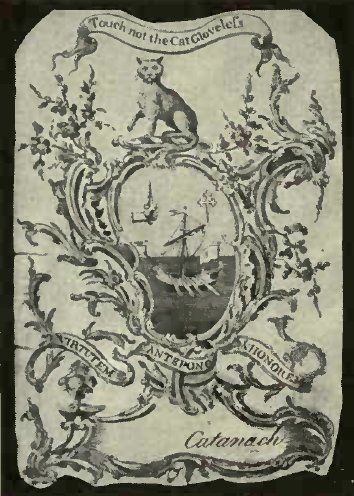
Perhaps the unkindest picture given to us of a cat is from the pen of the naturalist Buffon. “ The cat “ (says this unsympathetic student) “ is an unfaithful animal, kept only from necessity in order to suppress a less domestic and more unpleasant one, and although these animals are pretty creatures, especially when they are young, they have a treacherous and perverse disposition, which increases with age, and is only disguised by training. They are inveterate thieves ; only when they are well brought up they become as cunning and flattering as human rascals.“
Chateaubriand, referring to these scathing remarks, says: “ Buffon has belied this animal. I am labouring at her rehabilitation, and hope to make her appear a tolerably good sort of beast.“
A charming reference to the ways of cats occurs in a curious and interesting book by a 0nce famous Jesuit, Father Bougeant, who lived in the first half of the eighteenth century. There is an English translation of this work, which has passed also into other languages and several editions.
This is the passage translated :
“ Such is one of those big-whiskered and wellfurred torn cats, that you see quiet in a corner, digesting at his leisure, sleeping if it seems good to him, sometimes giving himself the pleasure of hunting, for the rest enjoying life peaceably, without being troubled by the events which agitate us, without tiring his mind by a thousand useless reflections, and little caring to communicate his thoughts to others. Truly it needs only that a female cat (une chatte) come on the scene to derange all his philosophy ; but are our philosophers wiser on such occasions ? „

The cat, as the emblem of independence and liberty, has been used in heraldry, statuary, and signboards. In the sixteenth century a well-known firm of printers named Sessa, at Venice, adopted the device of a cat surrounded by curious ornamentation, and Dibdin in one of his works tells us that whenever you you see Sessa’s cat you may be sure the book is a good one and worth reading.
Ever since the days when the Romans carried on their banners the design of a cat, this combative and courageous animal has been a favourite symbol of warriors and nobles. The wife of King Clovis, Clotilde,had a cat sable upon her armorial bearings, springing at a rat, and on the famous Katzen family’s shield was a cat holding a mouse in its mouth.
In Scotland the Clan Chattan was known by the emblem of a wild cat with the significant motto, “ Touch not the cat, but “ (meaning without) “ the glove.“Their chief was called Mohr au chat, or the great wild cat.
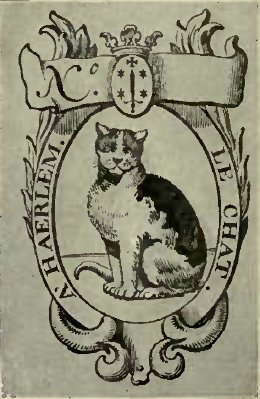
M. Champfleury, dealing with cats in heraldry, tells us that the French Republic resumed heraldic possession of the cat and added it to its glorious shield of arms ; and an illustration is given in his book of the republican painter’s figure of Liberty holding a pike surmounted with a Phrygian cap, and at her feet is seated a cat.
In past rather than in present, days the cat was used on signborards, especially in France. We read of “La Maison du chat pelote” (i.o. which rolls itself up) and “La Maison du chat qui pêche.” In the Lombards’ quarter of Paris, “Le Chat Noir” was formerly a familiar figure above restaurans and confectioners. In England we often come across “The Cat and the Fiddle” as a signboard to old country village inns, and in Cassell’s “Old and New London” a writer says “Piccadilly was the place in which “The Cat and Fiddle” first appeared as a publichouse sign. The story is that a Frenchwoman, a small shopkeeper, had a very faithful and favourite cat, and that in lack of any other sign, she put over her door the words : ‚ Voici un chat fidele.‘ From some cause or other, the ‚ Chat Fidele ‚ soon became a popular sign in France, and was speedily Anglicised into “The Cat and Fiddle”, because the words form part of one of our most popular nursery rhyhmes”.
Many are the popular traditions, maxims, proverbs, and superstitions connected with the cat. In olden days her every movement was looked upon as a sign of ill-omen or of good luck. Old nurses would drive a cat out of the bedroom with much significance of manner, that it might not “ suck the child’s breath.“ There is a superstition that a cat will not remain in a house with an unburied corpse.
M. Presse d’Aveunes gives an account of a curious cat superstition. “ When a woman gives birth to twins, boys or girls, the last an illustration is given in his book of the reborn of the two, whom they call ‚ barecy ‚ publican painter’s figure of Liberty holding a (sometimes both), has at times, and it may pike surmounted with a Phrygian cap, and at be all its life long, an irresistible craving for her feet is seated a cat. particular eatables ; and in order to satisfy more easily its gluttonous desires, it assumes the shape of different animals and especially that of the cat. During the transmigration of the spirit into another shell, the human body is as a corpse, but when the spirit has satisfied its desires it retakes its proper form.
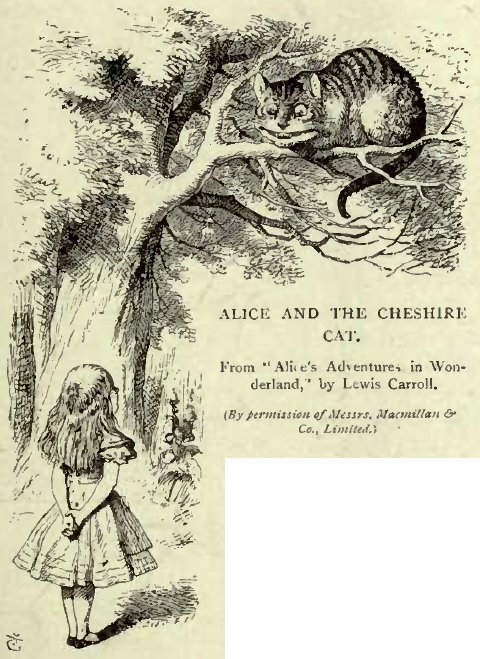
He continues : “ Having one day killed a cat which had made inroads upon my larder, a druggist of the neighbourhood came to me in a great fright and entreated me to spare all animals, for he said he had a daughter who had the misfortune to be a ‚ barecy,‘ and that she was often in the habit of assuming the shape of a cat in order to eat the sweetmeats served at my table.“
Milton tells us “ that when the cat washes her face over her eares, we shall have a great store of raine.“ A cat sneezing is supposed to bring luck to a bride on her wedding day. Sailors have in all times been prone to superstition as regards cats. A black cat’s appearance on the ship foretells disaster, but if a cat should disappear overboard the greatest consternation is caused amongst the crew.
Very plentiful are the nursery rhymes, fairy tales, and stories concerning cats a good-sized book would not contain them. “ The cat,“ says M. Champfleury, “ is the nurse’s favourite and the baby’s earliest friend.
It plays its part in little rhythmical dramas, cunningly presented to the drowsy child, who falls asleep with a familiar image parading fantastically through his brain.“ French nursery rhymes are much prettier than English. For instance, this bald and commonplace statement is not calculated to catch the attention of the juvenile mind :
“ Great A, little A, bouncing B, Cats in the cupboard, and can’t see me.“
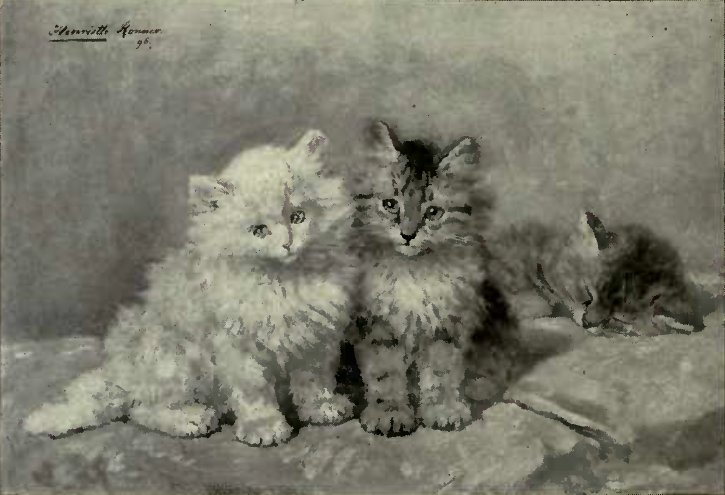
How much softer and daintier are the following lines :
„A, B, C,
Le chat est alle
Dans la neige ; en retournant
II avait les soulicrs tout blancs.“
In passing, I should say it is strange that to the French a cat is always masculine, and to the English feminine.
In the days of good Queen Anne the story of pussy’s venturesome journey to London was put into verse, and what child has not listened eagerly to these lines from that time down to our present day ?
“ ‚ Pussy-cat, Pussy-cat,
Where have you been ? ‚
‚ I’ve been to London To see the Queen.‘
“ ‚ Pussy-cat, Pussy-cat,
Whhat did you do there ? ‚
‚ I frightened a little mouse
Under her chair.‘ „
In “ Alice in Wonderland “ Lewis Carroll has given the world “ a childish story “ which will never cease to delight both young and old. In this we read of the „Cheshire Cat “ which grinned down upon the guests assembled at the royal croquet party, and having incurred the danger of the Queen, was in danger of having its head cut off by order of the infuriated monarch. The other volume by the same author “ Alice Through the Looking-Glass “ opens with a description of the way in which Dinah the cat washed her children’s faces : “ First she held the poor thing down by its ear with one paw, and then with the other paw she rubbed its face all over the wrong way, beginning at the nose.“ Then follows an animated conversation between Alice and the kitten. All the world knows of the love Lewis Carroll had for children, and I can assert he had an affection also for cats, for when a child he spoilt and petted me and my kitten. I only wish I could remember the deliciously impossible stories he was wont to tell me of fairies, goblins, and pussy-cats.
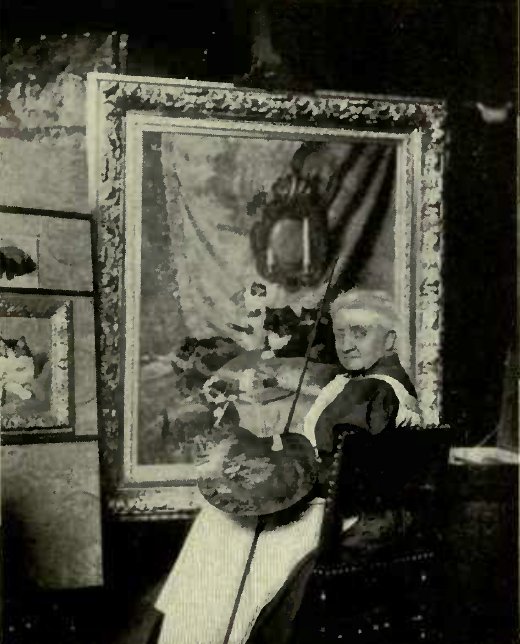
Harrison Weir, in his book on cats, has gathered together a number of curious cat proverbs. Some are very familiar, such as : “ A cat may look at a king “ ; “ Care will kill the cat “ ; “ When the cat is away the mice will play,“ and a very significant one is : “ When the maid leaves the door open the cat’s in fault.“ The quaint saying, „When candles are out all cats are gray “ is a very expressive one. When we consider the cat in art, it is among Eastern painters we find the most delicate and skilful studies.
Next to the Egyptians, the Chinese and Japanese have excelled in the artistic treatment of animals. In many of the Dutch interiors given to us by Flemish artists, the domestic cat may be seen curled up on the hearth, or sitting erect, bearing somewhat the appearance of being stuffed with bran. In many of the early Italian sacred pictures we find the cat depicted, but great painters, like Titian, Velasquez, and Murillo, seem to have preferred the dog as an adjunct to their portraits. Raphael and Salvator both considered puss a worthy subject for their brush. In M. Champfleury’s interesting book on cats he gives a facsimile from the powerful pencil of Mind, whom Madame Lebrun has termed “ the Raphael of Cats.“ The attitudes are so true to nature that the cat seems alive. Mind was a native of Berne, and in 1809, on account of a scare of madness amongst cats, eight hundred were put to death. This was a heartbreak to the cat-loving painter, who, however, managed to save his favourite pet Minette from the wholesale massacre.
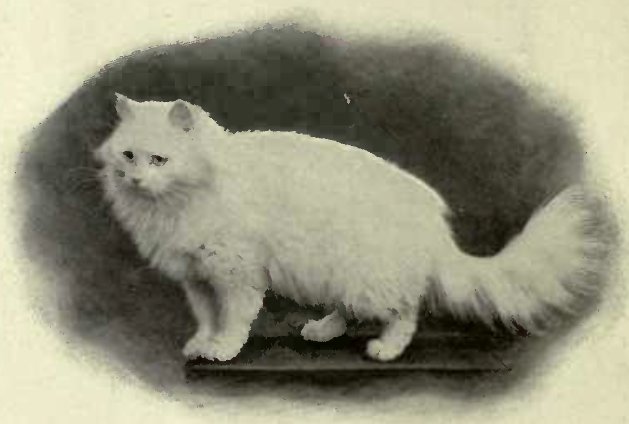
Very quaint reproductions of cats have been made in the following wares : Whieldon, Salt Glaze, Agate, and Staffordshire. With Chinese and Japanese cat figures we are all familiar ; they are grotesque rather than beautiful. Coming down to the cat artists of the present day, we would mention Madame Henriette Ronner, who has justly deserved the great reputation that she has acquired in her own country as well as ours. It is in depicting kittens in their ever-varying moods that MadameRonner most excels.
Whether playing havoc with antique lace, as in “ Un Bout de Toilette,“ scattering an artist’s materi- als, as in “ Mischief,“ or drag-ging jewels from a casket, her kittens are instinct with vitality, and are portrayed in a manner implying knowledge of their anatomical structure, as well as in a most appreciative perception of their youth and beauty. Most lovers of cats are acquainted with Madame Ronner’s artistic volume containing so many faithful and lovely reproductions of several of her best pictures, and an interesting account of her life and work written by Mr. M. H. Spielmann.
Another famous painter of cats is M. Eugene Lambert, who may be said to divide the honours with Madame Ronner in portraying with fidelity and artistic taste the feline race. Among English animal painters we have none who can come anywhere near to these two celebrated French artists in their marvellous delicacy of touch andsubtle skill in depicting cat and kittens. In these latter days who is there amongst us, young and old, who has not enjoyed a hearty laugh over the comical cats of Louis Wain ? In his particular line, he is unique, for no one has ever portrayed cats in such various attitudes and with such deliciously expressive countenances. The adjectives and adverbs of the Cataract of Lodore would not suffice to describe the varied emotions of these funny felines. A Christmas without one of Louis Wain’s clever m catty pictures would be like a Christmas pudding without the currants !
To Harrison Weir cats and cat lovers owe a debt of gratitude. He has done much to raise the standard of the feline race, and in his excellent book called „Our Cats,“ he thus writes in his preface :
„Long ages of neglect, ill treatment, and absolute cruelty, with little or no gentleness, kindness, or training, have made the cat self-reliant ; and from this emanates the marvellous powers of observation, the concentration of which has produced a style analogous to reasoning, not unmixed with timidity, caution, wildness, and a retaliative nature. But should a new order of things arise, and it is nurtured, petted, cosseted, talked to, noticed, and tamed with mellowed firmness and tender gentleness, then in but a few genera-tions much evil that bygone cruelty has stamped into its retched existence will disappear, and it will be more than ever, not only a useful, ser viceable helpmate, but an object of unceasing interest, admiration, and cultured beauty, and thus being of value, it will be profitable.“
It was Harrison Weir who instituted and carried out the first Cat Show held at the Crystal Palace in 1871, and since then he has taken an active part in the cat world. Of late years, however, he has been failing in health, and it was suggested that some testimonial should be offered to him in his declining years by his many admirers and cat-loving friends. Our Cats, that popular weekly publication, opened a list in their columns, the result being a handsome piece of plate, which the veteran F.R.H.S. was asked to accept. In his reply acknovyledging the gift, he writes : “ Kindest and best wishes to those warm-hearted and truly unforgetful friends who have contributed towards the very handsome testimonial.“ Then he goes on to allude to the first cat show and to his prophecy regarding the growing popularity of the cat family : “ Did I expect the outcome to be what it is ? Yes, and no.
I fully expected large shows and more of them, and a ‚ Cat Press,‘ and in the papers cat columns for the universal and worthy favourite cat. But in another way I am disappointed, and that is for the neglect of the short-haired English cat by the ascendancy of the foreign long-hair. Both are truly beautiful, but the first in intelligence, in my opinion, is far in advance of the latter.“ Therefore, with a hope that Harrison Weir may yet live to see the English short-haired cats still more widely loved and appreciated, and given better classification at^otir shows, I will pass on to my chapter on present-day cats and cat clubs, and the many other institutions and societies which are the outcome of the rapid strides that have been made in the cat fancy since the day when Harrison Weir was laughed at by his incredulous and astonished railway companion as they travelled together to the first Cat Show held at the Crystal Palace in 1871.
